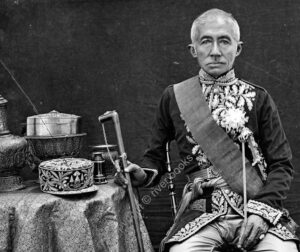When her husband died in Asia in 1859, Anna Leonowens, his wife, was left an impoverished widow with two children. Two other children had died in infancy. She returned to Singapore, where her husband had previously held a military post. The school she founded for the children of British officers did not do particularly well, but her reputation as an educator became established.
In the providence of God, she was invited to educate the children of the king of Siam (today’s Thailand).
The biography I read of her life makes her motivation clear: (1) she succeeded Dan Beach Bradley, an American missionary, as the teacher to the Siamese court; (2) in her official portrait (above) she is wearing a large cross; and (3) her biography said, “Mrs. Leonowen’s purpose was to awaken an interest in missionary labors . . .” While told by King Mongkut that her religion was not wanted, clearly this lady had a love for Jesus Christ and was motivated in her work by that allegiance.
In 1862, Anna Leonowens moved to Bangkok to undertake the education of King Mongkut’s 39 wives and concubines and 82 children. She served for five years in the court. Her story was the basis for Rodgers & Hammerstein’s highly sanitized and romanticized “The King and I.”
The king arranged filthy quarters for her. She objected and gained a decent place. Prostration – flat-out, face-on-the-ground prostration — was the normal way to be in the presence of the king. He liked to sit on the floor, but no head in the room could be higher than his, which meant crawling into his presence before getting even lower was normal. Once when he wanted a book, Anna knew where it was and went to get it. Unfortunately, it was in a room directly above the king so he later criticized her for “going over my head.”
 One time when she sought a raise in salary, he angrily drove her away saying that her frequent appeals for the poor and needy was the extra money she sought. By standing up for others, Anna Leonowens gained credibility in the court and became the acknowledged mother of the wives and children. Additionally, her battle of wills with the king slowly won his respect.
One time when she sought a raise in salary, he angrily drove her away saying that her frequent appeals for the poor and needy was the extra money she sought. By standing up for others, Anna Leonowens gained credibility in the court and became the acknowledged mother of the wives and children. Additionally, her battle of wills with the king slowly won his respect.
But God’s great achievement through Mrs. Leonowens was crown prince Chulalongkorn. She poured her ideas into his mind, including anti-slavery thinking. She helped shape his definition of an enlightened monarch.
After Anna returned to England, she wrote two books about her experiences in Siam. According to the biography I read, significant cruelty in King Mongkut’s court was normal. But Anna was criticized because the cruelty she documented was not validated by others. Another critic claimed Anna exaggerated her influence. Another claimed that while she was highly respected and even enjoyed a degree of political influence, she was never invited into the circle of British merchants of the area.

But it remains that after Chulalongkorn became king (at 15 years of age), (1) prostration disappeared, (2) he maintained a positive, healthy correspondence with Mrs. Leonowens for years after she left the court of Siam and (3) anti-slavery efforts which he started as an enlightened monarch resulted in the freeing of slaves by 1915 (he reigned until 1907). Her Influence was dearly bought and wisely used. May we do likewise.
Keith Kaynor
kmkaynor@gmail.com
More Bible-teaching illustrations are available
at www.kaynorkonnection.com With a 2000-entry
subject / topic / Scripture index, you should be able
to find what you need.

Recent Comments